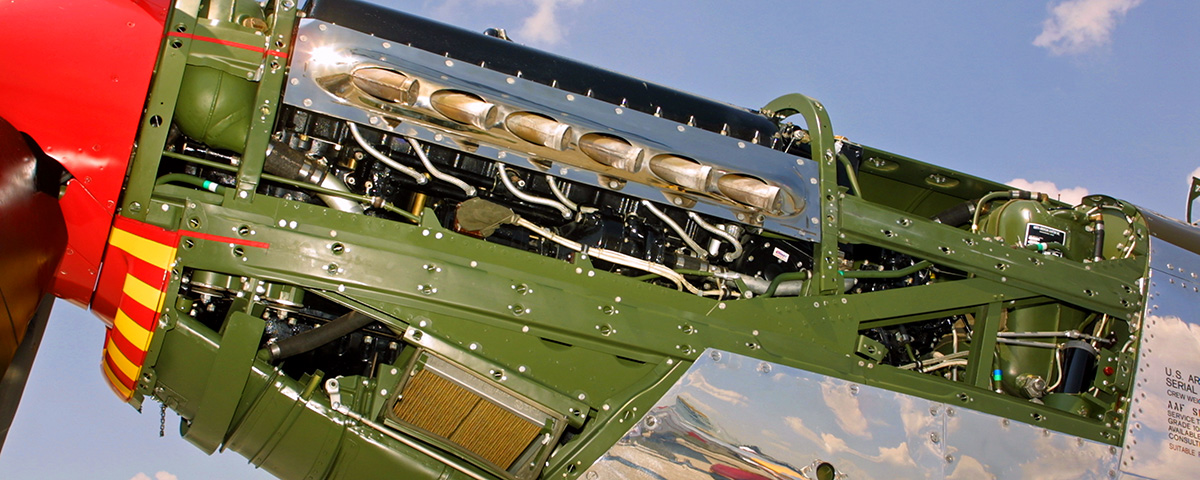The British Overseas Airways Corporation flight from Stockholm, Sweden, landed at an airfield in Leuchars, northern Scotland, one of several hundred round trips the airline made between the two cities. But this was no ordinary flight. The year was 1943, and although the plane carried civilian markings and the pilot and navigator were nominally civilian employees of BOAC, it was a de Havilland Mosquito bomber. And the passenger who emerged, stiff from being crammed into an improvised bunk in the bomb bay of the unpressurized aircraft, was physicist Niels Bohr, 1922 Nobel Prize winner and pioneer in nuclear fission research.
Bohr had determined that the uranium isotope U-235 could create a chain reaction, and therefore could be used to construct a powerful atomic bomb, findings he detailed at a January 1939 conference in Washington, D.C. By 1943 the Nazi roundup and deportation of Jews in Denmark put Bohr at great risk, as his mother was Jewish. Word leaked that he was about to be arrested and would face a stark choice: Join Adolf Hitler’s atomic weapon project or be sent with his wife and son to almost certain death in a concentration camp.
With the help of the British secret service, Bohr had been smuggled to neutral Sweden. On December 6 he flew from England to the United States to join the Manhattan Project.
The Mosquito was the only aircraft fast enough to evade German fighters patrolling the North Sea to intercept the BOAC flights, which conveyed clandestine personnel and precision supplies such as ball bearings. The Nazi atomic bomb project ultimately fizzled, but it might have ended differently if Bohr had been in charge, coerced by threats to his family.
Of course, he might never have been rescued if Britain had lost the ferocious aerial struggle for its existence in the summer of 1940. If the close-run Battle of Britain had gone the other way, Great Britain, with much of its armor, trucks and heavy weapons left behind in the evacuation of Dunkirk, would have been in a precarious position. The effect of a possible British capitulation on subsequent events in Russia, North Africa, Normandy and the Far East can only be imagined.
Two months after Bohr’s harrowing flight, on December 13, 1943, North American P-51B Mustang fighters accompanied 710 U.S. Army Air Forces bombers on a mission to Kiel, Germany. The 980-mile round trip was the first fully escorted long-distance raid of the war, and the beginning of successful daylight precision bombing and the progressive destruction of the Luftwaffe.
These three momentous events—Bohr’s rescue, Germany’s defeat in the Battle of Britain and America’s long-distance fighter escort missions—had one thing in common: They were all made possible by the same aero engine—the magnificent Rolls-Royce Merlin. Without the inspired genius of a gifted mathematician and the dedication of a small group of engineers who developed the Merlin, the world today might be a very different place.
The Merlin’s origins date back to the 1920s, with the 21-liter V12 Kestrel, the first Rolls-Royce production engine to be supercharged. Strongly influenced by the Curtiss D-12, the Kestrel’s basic design was so sound that its derivatives, in various sizes and versions, were produced to the end of the company’s piston engine era. Its enlargement to 37 liters resulted in the Buzzard, from which a 1929 racing version, called simply “R” by Rolls-Royce, eventually developed 2,500 hp. The R gave Britain victories in the Schneider Trophy seaplane races three years in succession, a world air speed record of 407.5 mph and possession of the trophy in perpetuity. Significantly, the winning planes were designed by Reginald J. Mitchell and built by the Supermarine Company. Thus the stage was set for the engineers and designers of Rolls-Royce and Supermarine to create, five years later, the immortal Spitfire.
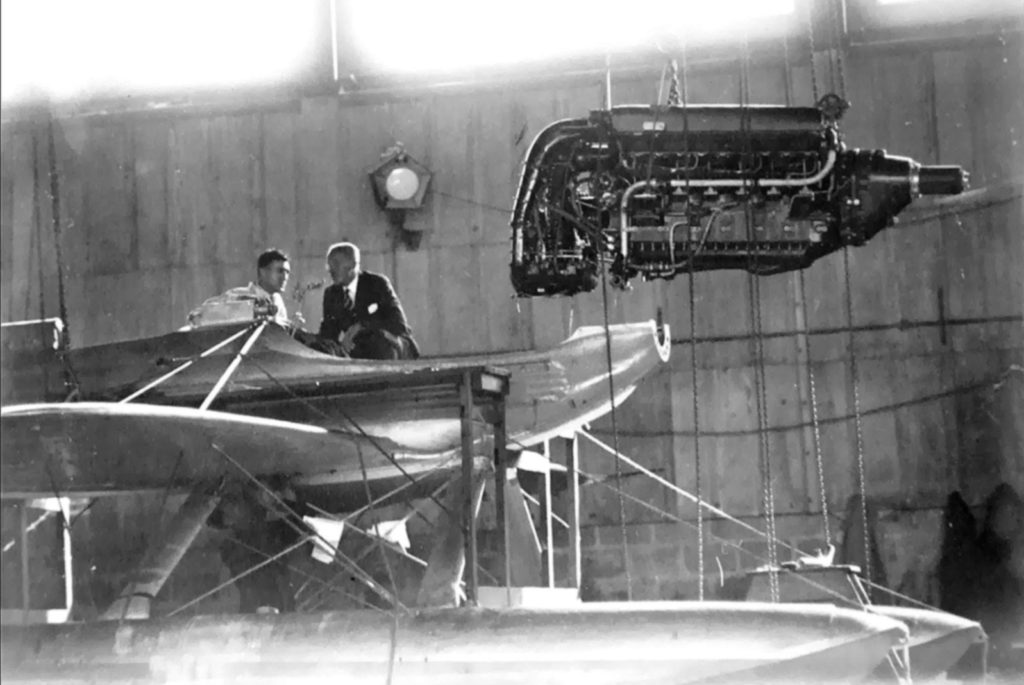
The R also powered cars to world land speed records, ultimately achieving 357 mph in 1938, and a boat to a world water speed record of 142 mph in 1939. As a result, before World War II the engine held or had held all three world speed records, on land, water and in the air.
Despite popular lore, the Merlin was not a derated R; instead it was the most important development of the Kestrel, enlarged to 27 liters. Another myth holds that the engine was named after the wizard of Arthurian legend, but in fact it simply followed Rolls’ practice of naming its inline aero engines after birds of prey. The merlin is a species of falcon with thin, pointed wings that allow it to dive at high speeds. It was an appropriate choice in view of the engine’s future use.
The first engines, called PV-12 for Private Venture 12-cylinder (as no government funds had been allocated to the design), were ready for bench testing in 1933, rated at 790 hp. The engine, now uprated to 950 hp, first flew in 1935 in a Hawker Hart, Sydney Camm’s last biplane and a forerunner of his Hurricane.
Type testing revealed a host of problems—particularly in the cylinder head design, bearings and gears—which had to be corrected for the engine to become a practical power plant. By the mid-1930s it was still unreliable, repeatedly failing the civilian 50-hour type test. It seemed the Merlin would never be successful.
It should be remembered that at the time Rolls-Royce was a relatively small company, employing fewer than 7,000 people. Simultaneously with the Merlin, it was also working on several other piston aero engines and a marine Merlin for use in fast patrol boats. In 1938 the company would also undertake development of gas turbine (jet) engines. By 1945 Rolls employed more than 55,000 people.
With war clouds gathering and aircraft manufacturers clamoring for the new engine, they continued to improve the Merlin, following Sir Henry Royce’s 1915 principle of identifying the weakest link by gradually increasing the engine’s speed and load, redesigning the problem component and going on to demand even more, even if this meant running it to destruction. Other than dynamometers, instrumentation of the period was rudimentary. But the company had technicians and mechanics of exceptional talent and experience in the testing shops, who, like Royce, had worked their way up through long apprenticeships. They could tell instantly when the sound of an engine changed, and detect the onset of detonation (knocking) by holding a short piece of steel between their teeth and resting the other end on the cylinder block of an engine running at full throttle. Thus the Merlin experienced a steady increase in power output that, in 12 years, would more than double its original rating while retaining reliability.
Rolls-Royce was extremely fortunate in being able to lure the brilliant young Stanley Hooker away from the Admiralty Research Laboratories in 1938. An Oxford graduate in mathematics, he had also done postgraduate work on fluid dynamics, and would become probably the world’s greatest expert in fluid- and thermodynamics applied to supercharging. In Hooker’s hiring interview at the Derby plant, Works Manager Ernest W. Hives questioned him on a technical point. “I explained as best I could,” recounted Hooker, “and then he said, leaning forward, ‘You’re not much of an engineer are you?’ I had to agree, and he replied: ‘Never mind, this place is full of the best engineers in the world and they will teach you….’”
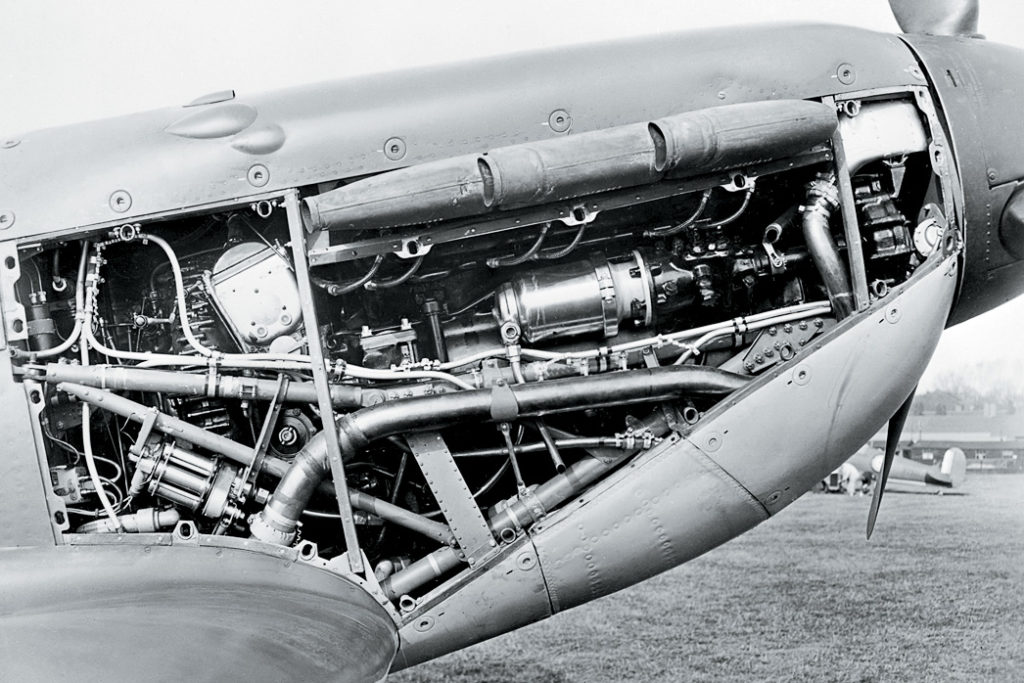
On joining Rolls-Royce, Hooker was surprised to learn that supercharging science was scanty, despite aircraft engines having used pressure boost since before World War I. All the formulas being used to design superchargers were based on parameters derived by the Royal Aircraft Establishment that he found to be inaccurate. Hooker approached the head of the Experimental Workshop and asked to see a supercharger. “Which supercharger?” he was asked. “Any one will do, because I’ve never seen one before.” He was then taken to a test rig. “This is a Merlin engine. This is the front end where the propeller is bolted on, and this contraption at the back end is the supercharger with the gears that drive it. And it’s your job to make it do better.”
As a new employee, and a mathematician to boot, Hooker was at first hesitant to question the work of Rolls engineers who had produced the giant supercharger that enabled the R engine to win the Schneider Trophy and set a new air speed record. He checked and rechecked his calculations: The figures were unassailable. Redesigning the rotor and diffuser would yield an immediate 15-percent increase in efficiency, and that would only be the start. Within a few months Hooker, who had never previously seen an aero engine either, added 30 percent more power to the Merlin. (He went on during the war to turn the rudimentary Whittle turbojet into a production engine, raising its thrust from 1,800 pounds to 5,000. By the time he retired in 1967, after being knighted by the queen, Sir Stanley Hooker had been deeply involved in the design of almost every modern British aero engine, including those for the Concorde supersonic airliner and the Harrier jump jet.)
Many brilliant engineers worked doggedly, and in some cases into early graves, to develop the Merlin, but it was Stanley Hooker who, by applying advanced scientific principles to the flow and compression of air, was most responsible for boosting its power from 1,025 hp at the beginning of WWII to well over 2,000 hp at the end. The Merlin consistently outperformed considerably larger aero engines.
The exhaust-driven supercharger, or turbocharger, seems to offer something for nothing, utilizing otherwise wasted heat energy from the engine’s exhaust to drive the supercharger, instead of the power-consuming geared method. It was the preferred system of boost for high-altitude operations for American military radial aircraft engines in WWII. Rolls-Royce had experimented with turbocharging on its Condor III engine as far back as 1923.
In discussions about its possible use with the Merlin, Hooker pointed out the lack of suitable locations for a turbocharger on the Hurricane, Spitfire or Mosquito, and proposed that exhaust energy could be utilized in a much simpler way. Experiments with exhaust stack designs had produced a short ejector shape imparting reaction (“jet”) thrust that added aircraft speed equivalent to an additional 150 hp. This would be lost in turbocharging. He predicted that the turbocharger’s main benefit—maintaining power at high altitude—could be obtained by using two superchargers in series, driven by the same engine gears. In fact the Merlin 61, the first equipped with a two-stage supercharger, increased the Spitfire IX’s ceiling from 30,000 to 40,000 feet and its top speed by 70 mph.
The appearance in September 1941 of the new Focke Wulf Fw-190A, with its 42-liter BMW radial engine, came as a nasty shock to the RAF, as it easily outclassed the Merlin 45–powered Spitfire V in speed and climb. But within weeks, Rolls was producing the Merlin 61. Only two-thirds the size of the Fw-190’s engine, it nevertheless produced more power, especially at high altitudes, where most of the action took place. Equipped with the Merlin 61, the new Spitfire IX regained the upper hand, surprising Luftwaffe pilots with its performance surge, since the two Spitfire types looked almost identical. Air Marshal Sir Harry Broadhurst, a top WWII RAF fighter pilot, vividly recalled his first flight in a Spitfire IX, particularly the astonished look on the face of an Fw-190 pilot as Broadhurst climbed past him with ease.
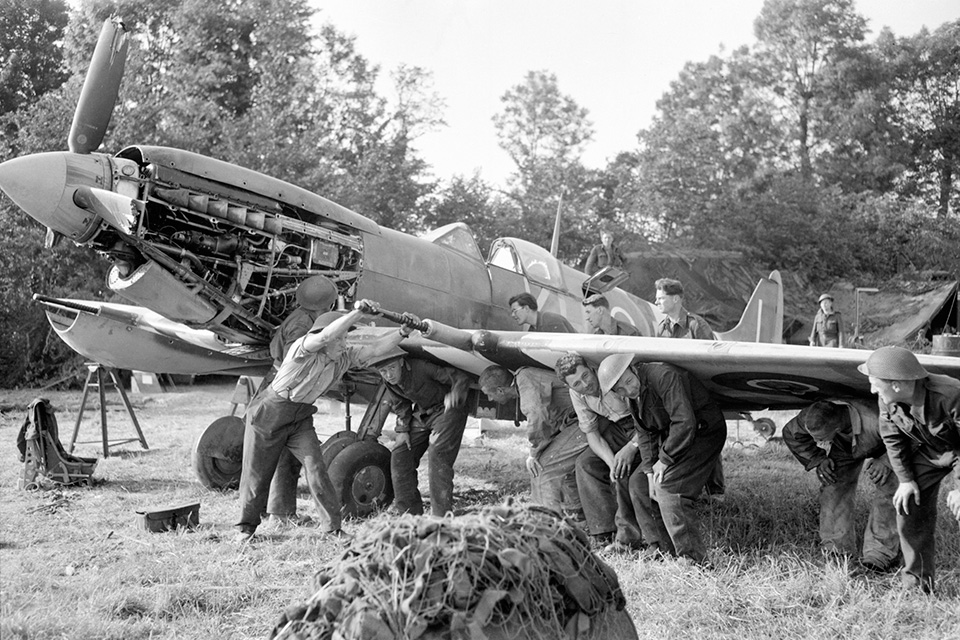
In a similar horsepower race with the Merlin (and later Griffon), the 34-liter Daimler-Benz DB 601—which powered the early Spitfires’ main adversaries, the Messerschmitt Me-109E and F—grew into the 36-liter, 1,475-hp DB 605 in the 109G. But by then the Spitfire IX’s Merlin 61 was producing 1,560 hp, soon to become 1,710 in the Merlin 70. Daimler-Benz finally enlarged the 600 series into the 44.5-liter 603. With only 40 more horses than the Merlin 70, and too heavy for any of the Luftwaffe’s single-engine fighters, it was relegated to twin-engine aircraft. The similar Jumo 211 V12 from the other major German engine manufacturer, Junkers, fell halfway in size between the DB 601 and 605 at 35 liters, but by 1942 was only yielding 1,400 hp.
Germany’s comparatively deficient engine power has been mistakenly blamed on the scarcity of high-octane fuel. But Britain entered the war with aviation gasoline of around 87-octane “regular,” while Germany already had 100-octane. By 1942 the Germans had raised this to 150. Rolls had tested the Merlin with 100-octane gasoline, and found it would happily motor on with manifold pressure raised from 43 to 48 inches of mercury, boosting output by 135 hp, but this was of academic interest as there was no 100-octane fuel in the RAF’s storage tanks. Fortunately, the Esso tanker Beaconhill arrived from the United States just before the Battle of Britain, bringing enough of the new fuel to serve the Hurricanes and Spitfires throughout the conflict. With higher permissible boost pressures, the additional speed and rate of climb were decisive. Without it, what was in the words of the Duke of Wellington (referring to the 1815 Battle of Waterloo) “a damned close-run thing” might well have turned the other way.
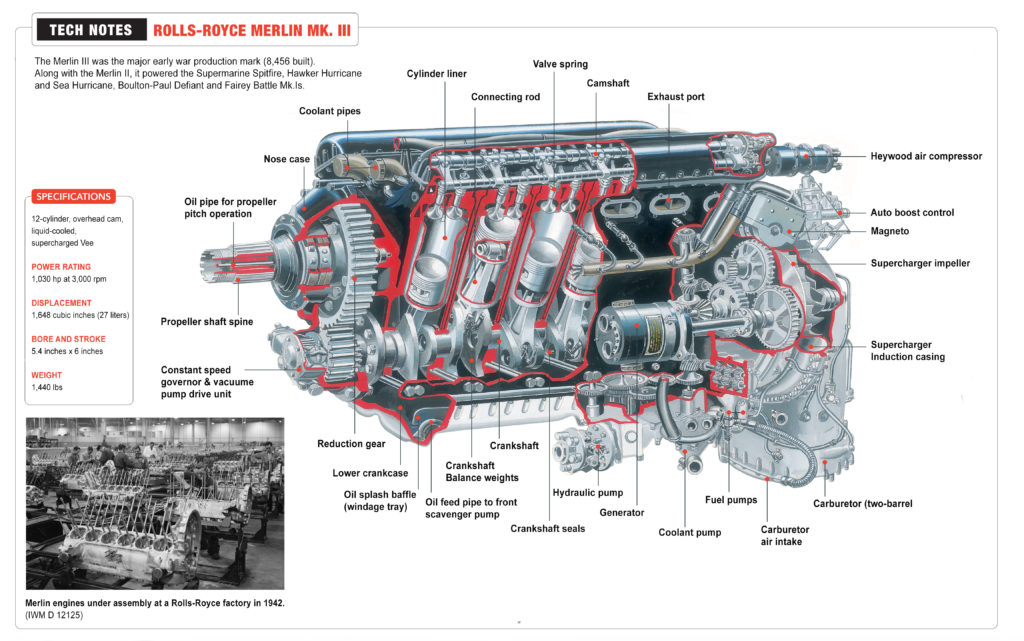
Direct fuel injection in the Daimler-Benz engines yielded a temporary advantage. In combat a Messerschmitt pilot, pursued by an early Hurricane or Spitfire, could push the stick forward and dive, while the same maneuver would cause the Merlin to cut out due to mixture leaning from negative G. The carburetor’s float would respond to what it now thought was “down,” flooding the engine for several seconds—and several seconds can mean life or death in aerial combat. RAF pilots would roll inverted and pull back on the stick to keep positive G, but by that time their quarry had frequently escaped.
Beatrice “Tilly” Shilling, a scientist at the Royal Aircraft Establishment, designed a simple flow restrictor to solve the problem. Resembling a metal washer, it allowed a maximum fuel flow of what was required at full throttle. The device became known at the Rolls factory by the somewhat indelicate name “Miss Tilly’s Orifice.” Luftwaffe pilots, accustomed to escaping by diving, now experienced a nasty surprise on finding the pursuing Hurricane or Spitfire still behind them. Later models of the Merlin used in fighters utilized Bendix or Rolls-Royce single-point fuel injection into the eye of the supercharger impeller, and Miss Tilly’s Orifice eventually passed into legend.
Radial engine proponents point out that liquid-cooled power plants are more vulnerable to battle damage: While a radial often continued to run even with a cylinder shot completely off the crankcase, a bullet in the cooling system of its inline counterpart could bring the flight to a rapid end. But well-designed liquid-cooled engines like the Merlin could run for long periods beyond normal operational limits without overheating, as liquid cooling is more efficient than air cooling, particularly for the cylinder head and valves. And they could operate at higher altitudes, reducing risk from anti-aircraft fire.
Far from being delicate and temperamental, as some “round engine” devotees maintain, the Merlin proved time and again that it could take abuse and still bring wounded aircraft home. Accounts of its fortitude are legion, including heavy bombers returning with half their engines disabled by flak or fighters, using throttle and boost far beyond the specified maximums for hundreds of miles. For example, one bomber pilot wrote, “I had to return from Nuremburg in a Wellington on one engine and used maximum boost and revs on a Merlin X for five hours with no sign of distress.” In another incident, an Avro Lancaster pilot who lost an engine just after takeoff pressed on to Stuttgart, fully loaded with fuel and bombs, using climb power on three engines for the whole trip.
The Merlin served in all war theaters, with all Allied air forces— including the Soviets—and was the only British engine to be used in American warplanes. In fact, it was in the P-51 Mustang that the Merlin, produced under license as the V-1650 by the Packard Motor Car Company, gained perhaps its greatest renown.
American precision daylight bombing of key targets deep inside Germany, by unescorted heavy bombers of the Eighth Air Force, began badly. By late spring of 1943, Luftwaffe strength was growing and its fighter tactics were improving. Bomber losses reached 14 percent during the April 17 raid on Bremen. In July 128 bombers were shot down, with 1,280 crewmen either killed or taken prisoner, and half the surviving aircraft had suffered battle damage.
The assumption that bombers, flying in mutually defensive formations, could penetrate Germany without fighter escort all the way to the target was proving to be a disastrous repeat of the Luftwaffe’s experience against Britain three years earlier. It persisted in the face of all the evidence for the same reason: There were no suitable long-range fighters. The Republic P-47’s radius, even with drop tanks, was only 400 miles. The twin-engine Lockheed P-38 had the range, but in a dogfight was outperformed by well-handled single-engine fighters, just as the Messerschmitt Me-110 had been in 1940. Losses in raids on Schweinfurt and Regensburg on August 17 reached as high as 20 percent, and a return raid on Schweinfurt on October 14 resulted in an intolerable 27 percent loss—34 percent if planes scrapped on their return were counted—forcing the Eighth Air Force to suspend raids until a solution could be found.
Even if a factory was hit, it was almost impossible to destroy the vital machine tools and presses. Once wreckage was cleared away, production often restarted within days. Despite temporary disruptions, German fighter production continued to increase until the war’s last months. The Germans simply decentralized their fabrication and assembly to smaller, satellite plants and cottage industry sites.
The Allison V-1710, the only American inline engine used in WWII, was very similar to the Merlin in several ways, but lacked the power development potential and altitude capability, relegating the RAF’s early Allison-powered Mustangs to low-level photoreconnaissance. In a marriage made in heaven, five P-51s were fitted with Merlin 65s at Rolls-Royce’s research airfield at Hucknall in 1942, transforming a good fighter into a superb one, faster than the Fw-190 and Me-109 at all altitudes and superior to both in virtually all respects. Carrying 270 gallons of fuel internally and two 75-gallon drop tanks, the Packard Merlin–powered Mustangs had an endurance of 7½ hours. They could escort the B-17s and B-24s to any target in Germany, and outfight any Luftwaffe plane on the way there and back.
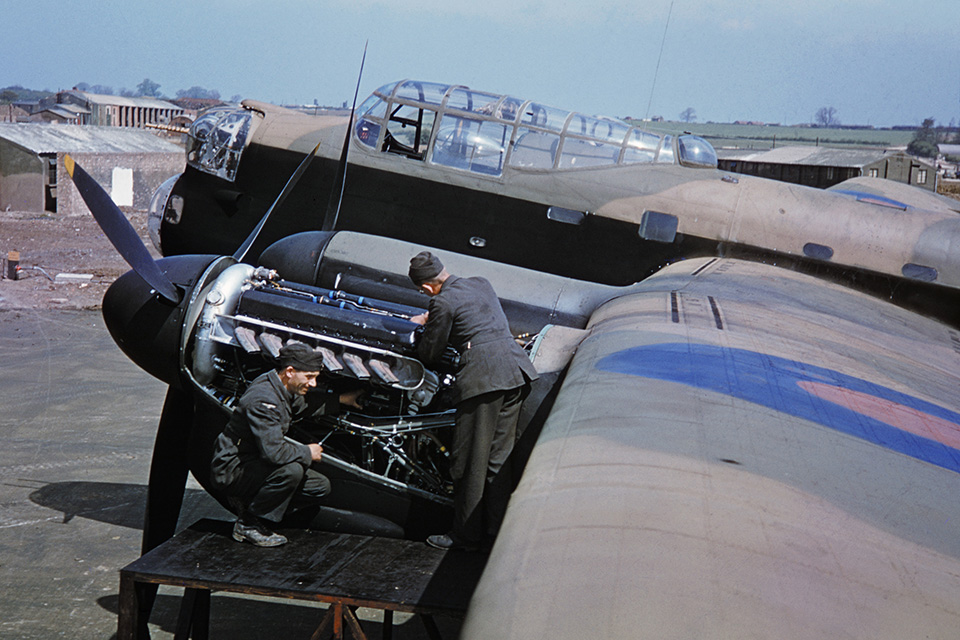
Legendary 357th Fighter Group ace Clarence “Bud” Anderson wrote of the Merlin-equipped Mustang in his memoir To Fly and Fight, “The Merlin had great gobs of power, and was equally at home high or low, thanks to a two-stage, two-speed supercharger.” Bob Goebel, who flew Mustangs with the 31st Fighter Group in the Mediterranean theater, explained the supercharger’s operation in Mustang Ace: “The P-51 had a two-stage blower in the induction system that was controlled automatically with a barometric switch. Around 17,000 feet, when the throttle had been advanced almost all the way forward just to maintain normal cruise, the blower would kick into high, the manifold pressure would jump up, and the climb could be continued to 30,000 feet.”
Although bomber losses dropped dramatically with the Mustang escorts, Maj. Gen. James H. “Jimmy” Doolittle believed the Eighth Air Force was committing the same mistake Hermann Göring had in the Battle of Britain—compelling the escorts to stay close to the bombers instead of allowing them to range free, around and ahead of the formation. On assuming command of the Eighth on January 6, 1944, he noticed a sign at VIII Fighter Command headquarters: THE FIRST DUTY OF THE EIGHTH AIR FORCE FIGHTERS IS TO BRING THE BOMBERS BACK ALIVE. Doolittle ordered it changed to: THE FIRST DUTY OF THE EIGHTH AIR FORCE FIGHTERS IS TO DESTROY GERMAN FIGHTERS. The bombers would be bait to trap the Luftwaffe, the objective being the total destruction of its fighter arm and the achievement of Allied air superiority over Europe, in preparation for D-Day and to enable U.S. and British aircraft to bomb key targets at will.
Soon whole fighter groups were allowed to freelance, and the Luftwaffe hunters became the hunted. Communication experts in England monitored German radio transmissions and vectored the Mustangs in to attack enemy fighters as their formations assembled. Free-ranging Mustangs destroyed German fighters, including Messerschmitt Me-262 jets, on the ground or during takeoff and landing. In February and March 1944, the Luftwaffe lost 4,236 aircraft. Although German fighter production rose from 24,807 in 1943 to 44,000 in 1944, lack of fuel and relentless pressure by the Allied air forces overwhelmed the Luftwaffe. Pilots were being killed faster than they could be replaced, and by the time of the last major Allied raid on April 25, 1945, the once-dominant force had virtually ceased to exist.
Without the P-51 Mustang, and its Merlin engine, the Allies could not have achieved air superiority over Europe in 1944. The Normandy invasion might have been delayed or even failed, and the war could have dragged on into 1946. The prospect of a strong Luftwaffe, equipped with thousands of piston engine and jet fighters—not to mention scores of Arado Ar-234 jet bombers—is unpleasant to contemplate. Instead, as Albert Speer, Hitler’s armaments minister, told the Japanese ambassador at the outset of the escorted bombing campaign, “For the first time…raids, which might deal a really fatal blow to Germany, have begun.”
The 1939 Merlin Mk. I was rated at 950 hp. By 1945 the Merlin RM17SM had been flight-tested at a continuous 2,200 hp, with 2,640 hp available for short periods. No other engine achieved such a remarkable power increase while continuing to run reliably. Some 160,000 Merlins were produced during WWII, more than 100,000 in Britain, the rest by Packard in the U.S. They were used in more applications—air, marine and land—and appeared in more marks (50) and power ratings (21) than any other engine. They powered aircraft of more purposes (nine) and types (31). Today Merlins continue to propel many warbirds in the U.S., Britain and elsewhere, and the engine’s throaty growl can still be heard at airshows around the world.
In an ironic coda to the Merlin story, the final variant of the Me-109, the Spanish-built Hispano Aviación HA-1112-M1L Buchón, was equipped with the 1,600-hp Merlin 500-45 engine. Remaining in service until December 1965, it was later used, disguised as Me-190Es and Gs, in films such as Battle of Britain, Memphis Belle and The Tuskegee Airmen. And so the circle was completed: 30 years earlier, a Rolls-Royce Kestrel had powered the prototype Messerschmitt Bf-109V1.
Nicholas O’Dell served in the RAF from 1958 to 1962. For further reading, he recommends: Clash of Wings, by Walter J. Boyne; Allied Piston Engines of World War II, by Graham White; and Not Much of an Engineer: An Autobiography, by Sir Stanley Hooker and Bill Gunston.
Originally published in the September 2009 issue of Aviation History. To subscribe, click here.

